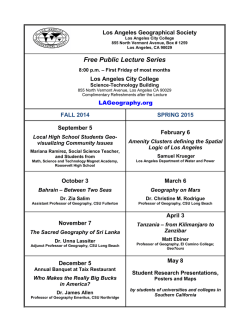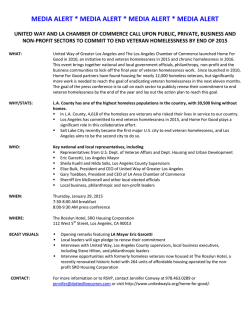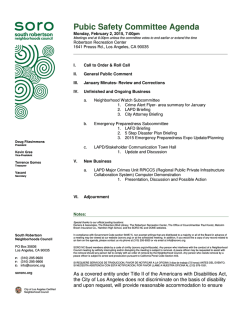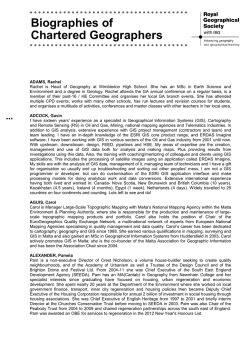
an example - California Geographic Information Association
County of Los Angeles GIS Case Studies Enterprise Geographic Information Systems (GIS) Enterprise GIS Steering Committee 12/10/2008 Table of Contents 2010 Local Update of Census Addresses (LUCA) .................................................................................................................... 1 Referral Address Verification Systems (RAVS) ........................................................................................................................ 2 Subdivision GIS Web Mapping Application ............................................................................................................................. 3 Local Owners Project Notification .......................................................................................................................................... 4 Mental Health Provider Directory Search ............................................................................................................................... 5 County Portal - Services Locator ............................................................................................................................................. 6 Childcare Provider Search Application .................................................................................................................................... 7 Mental Health Mapping Site ................................................................................................................................................... 8 Public Works Service Locator .................................................................................................................................................. 9 Geocortex Map Service for Parks.......................................................................................................................................... 10 Multiple Family Dwellings Risk Assessment.......................................................................................................................... 11 MLK Patient Referral Reimbursement Verification .............................................................................................................. 12 Mock Reassignment of Health Plan Members ...................................................................................................................... 13 Enhanced 911 Response ....................................................................................................................................................... 14 2010 Local Update of Census Addresses (LUCA) Chief Executive Office (CEO), Urban Research Group http://www.census.gov Problem: The County of Los Angeles provides services to the residents of the County. Many programs are supported by federal funding that is calculated by the number of residents of the County. The County is supporting the goal of the Census Bureau to find and count all County residents in the 2010 Census. Solution: The County LUCA program worked with 87 cities and identified over 149,000 residences that the Census Bureau did not know about. This represents an estimated 440,000 additional residents of the County, and $115 million per year in additional federal funding countywide. Summary: Every ten years, the U.S. Census Bureau (Bureau) prepares for the Decennial Census by preparing a Master Address File (MAF) of residences to which it will mail a Census questionnaire. The Bureau sent to the County Urban Research a CD containing 3.5 million residences with a simple question: which ones are missing? Working with 87 Cities, Urban Research created a list of every address it could document, including 7,000 inhabited Zoning Enforcement cases, and address matched (geocoded) the list to Census Tract and Block, individually connecting each matched address to those in the MAF. Special efforts were made to capture all Group Quarters, defined as where unrelated people live together (college dorms, prisons, camps, convalescent hospitals), mobile home parks, and especially, unpermitted residences from Cities’ Zoning Enforcement files. Some examples of what was found during this effort: 990 group quarters (20% more than the original 4,000) 50 unlicensed mobile home parks 6,000 mobile homes not in the Assessor file The City of San Fernando reported 4,500 residences and an additional 1,200 inhabited garages, a 28% increase. The County reported 149,000 new residences to the Bureau that were not in MAF; the Bureau accepted 143,000 of them (96%). We estimated that 3 persons live in each per residence - that is like finding a City of 440,000 people (slightly less than the City of Long Beach). The City of Los Angeles calculates that a counted person is worth about $269 per year for ten years. Using these numbers yields a very large potential revenue recovery of over $115 million per year of State and Federal funds to 87 Cities from a five-month project costing $250,000. Contact: Peter Fonda-Bonardi, Data Specialist [email protected] (562) 658-1804 1|Page Referral Address Verification Systems (RAVS) Department of Children and Family Services (DCFS) http://gis.lacounty.gov/ravs Problem: DCFS Child Protection Hotline (CPH) has no means of determining the accuracy of the referral address to appropriately assign referrals to Regional Office and cross reporting to Law Enforcement Agency. Solution: The Referral Address Verification System (RAVS) has greatly improved the accuracy of DCFS addresses; resulting in more accurate referral assignments to Regional Offices and cross reporting to Law Enforcement Agencies; thus, improving response times, lower costs, and better outcomes for children. Summary: LA County, Department of Children and Family Services (DCFS) Child Protection Hotline (CPH) responds to an average of 150,000 calls each month. Approximately 6,000 of the referral calls lead to the assignment of the referral to the DCFS Regional Emergency Response workers for an in-person investigation of child abuse or neglect allegation(s) and/or possible removal of the child from the home if safety risk is determined. By law, DCFS creates a cross report (SCAR - Suspected Child Abuse Report) to the Law Enforcement agency responsible for the DCFS Regional Office catchment area. Unfortunately, many of the addresses provided by callers are inaccurate; this results in wrong assignments of referrals to Regional Offices and cross reporting to Law Enforcement agencies, further increasing the children’s safety and risk factors. The Referral Address Verification Systems (RAVS) is a web-based application that provides the DCFS –CPH an on-line tool that validates the referral address while the caller is on the phone. If the entered referral address is incorrect, a list of alternative address options will be displayed, in which case, the DCFS-CPH staff will verify the address with the caller; once the correct address is identified, RAVS displays the map showing the location of the referral address and the name and address of the responsible DCFS Regional Office, Law Enforcement Agency and the Department of Public Social Services (DPSS) office. DCFS-CPH staff cuts/paste the correct address to the Statewide Child Welfare Services/Case Management System (CWS/CMS). RAVS has improved the productivity and efficiency of the DCFS-CPH staff in determining the appropriate office assignment and Law Enforcement cross reporting. It has increased the timely response rate of child abuse calls to 90% by improving the direction and coordination of resource allocation in emergency response situations. The rate of accurate referral address in CWS/CMS has increase from 70% to 95%. The improved accuracy of address location will help DCFS in the planning of resource and service allocation for the diverse demographics especially in the dispersed geographic areas of Los Angeles County. Contact: My Ngoc Trinh, Sr. GIS Analyst [email protected] (213) 351-5554 2|Page Subdivision GIS Web Mapping Application Department of Regional Planning (DRP) (SUB-NET) http://planning.lacounty.gov/intGisMaps.htm Problem: The public had limited access to subdivision information. It was available by appointment only, which restricted them to DRP office hours. Additionally, a significant amount of subdivision data is stored offsite, often necessitating a return visit. Solution: The GIS web mapping application SUB-NET was developed to provide the public with a way to view subdivision data via the Internet, providing them unrestricted access to detailed subdivision activity information along with access to scanned tract and parcel maps. Summary: The GIS web mapping application SUB-NET was developed as a way to store and retrieve all active subdivision maps and data in a quick and efficient manner. Built upon the framework of the Department’s existing web mapping application, GIS-NET, its goal was to incorporate subdivision data along with other existing GIS data and imagery. Initially deployed to Regional Planning staff, and then to a few select County agencies, it provides access to several years of subdivision information, including subdivision status and scanned tract and parcel maps. The public and other County agencies alike can now see proposed subdivisions along with neighboring projects throughout the unincorporated County instead of on a piecemeal basis. By opening SUB-NET to the community, DRP hours have ceased to be a problem as well. Since the County servers are running 24-7, the public now has access to the entire subdivision activity dataset at any time of day, any day of the week. SUB-NET has not only reduced staff workload at the public service counter, it also increased productivity and efficiency of DRP staff. As an internal planning tool, it has improved the overall quality of planning decisions by DRP staff due to the wealth of data stored in digital format. The cost avoidance is estimated to be $72,000 per year based on the number of employees affected and the time that would have been required to locate and gather subdivision records. An additional cost savings of $14,000 was also estimated due to the reduction in the number of meetings necessary to present the status of subdivision activity information to the public. 2008 Productivity and Quality Awards Program Winner Contact: Nick Franchino, GIS Manager [email protected] (213) 893-0881 3|Page Local Owners Project Notification Department of Beaches and Harbors (DBH) http://beaches.lacounty.gov Problem: Frequently when a Marina parcel is pending redevelopment, all surrounding property owners within a certain distance must be notified of the pending project. How do you know who to notify? Solution: A GIS allows us to accurately specify a radius around the site and then determine exactly which properties fall within that radius. Those owners are then notified of the pending project in a timely manner. Summary: Marina del Rey, an unincorporated part of Los Angeles County, falls within the California Coastal Zone. The Coastal Zone extends the entire length of the California coastline and also includes about 287 miles of shoreline around nine offshore islands. Excluding San Francisco Bay, which has its own coastal management program, the Coastal Zone encompasses some 1.5 million acres of land. It reaches from three miles at sea to an inland boundary that varies from a few blocks in urban areas to several miles in less developed regions. The Coastal Zone exists to ensure that coastal resources are protected, preserved, and where possible, restored for the enjoyment of current and future generations. As Marina del Rey falls entirely within the Coastal Zone, any development or redevelopment within it requires a Coastal Development Permit. Part of the permit application process requires the notification of all surrounding property owners within a specified radius of the subject parcel. A GIS allows an accurate determination of the specified radius, so that property owners can be duly notified of any pending projects. If so configured, the system will also allow for the compilation and creation of a database containing all the property owners’ names and mailing addresses. The accuracy of the GIS allows proper owner identification and notification in a timely and efficient manner. Contact: Chris Sellers, Planning Division [email protected] (310) 578-0961 4|Page Mental Health Provider Directory Search Department of Mental Health (DMH) http://gis.lacounty.gov/dmh Problem: The Los Angeles County Department of Mental Health has over 500 providers of mental health services to individuals all over the County. While some providers provide services to all age-groups, some of the providers restrict their services to certain age-groups. Finding appropriate services that are conveniently located close to a client’s home address was often a challenge. Solution: The DMH Online provider Directory allows the public to search for age-appropriate mental health services. The search locates the nearest service and provides information on the type of service delivered, source of provider (contractor versus Directly operated versus FFS), phone number and DMH service area boundary. Summary: The Los Angeles County Department of Mental Health serves approximately 220,000 clients annually. These services are provided by a wide network of providers that serve different age-groups and provide different services. Some of these services include outpatient, inpatient hospitalization, Day Treatment, Residential, Crisis Residential, Forensic, Institute of Mental Disease (IMD), Juvenile Justice, School Based, Severe Emotional Disorder (SED) services, Supportive Housing and Transitional Living services. The online Provider Directory Search allows the public to search for service closest to their location. The information provided includes a phone number, type of services provided by that provider, age-group served by that provider and the service area boundary in which the provider is located. In addition, the search engine is also very useful for case workers and program mangers to find and locate services. The Online Search engine has an Advanced Search page in which a provider can be located by certain search criteria, such as a Directly Operated Provider that provides school-based services to children and youth. The search engine returns the results sorted by distance and provides directions to the location. The online directory is available to the public and is being used by case workers and program managers to locate and provide appropriate services. The online directory is also being used by the Department’s 24 –hour Access Center that provides emergency psychiatric services and referrals. The ability of the search engine to find appropriate providers by location in under one minute allows the Access Center to provide timely services for psychiatric emergency needs. Contact: Vandana Joshi Planning Division [email protected] (213) 251-6886 5|Page County Portal - Services Locator Chief Information Office (CIO) http://maps.lacounty.gov Problem: Residents in the County Los Angeles found it difficult to find information about services near them. This resulted in calls to the County seeking information which took staff time and reduced the information available to the public. Solution: The Services Locator is a single location where residents can obtain information about their jurisdiction and see a map of nearby services. This will reduce the number of calls to the County for information and improve outreach to the public. Summary The County Portal contains valuable information about county and municipal services, including parks, health facilities, and recreation opportunities. County residents use the portal to find information about these services, including their location, contact information, and hours of operation. In the past, this information was listed on the sites of each department. This meant that it was scattered throughout the County Portal, which made it very difficult for residents to find services that were both nearby and relevant. Often, residents would call county departments or the Public Information Office to gain more information, taking County staff time and reducing the information available to the public. As well, many residents did not know which city they lived in or their representative. This meant that County staff would need to redirect them to the appropriate office, which involved time to research the correct contact information. The CIO, ISD, and the CEO Public Information Office decided to include a mapping system in the new County Portal to make it easy to find the services that were nearby and get critical information about those services. The map would provide a single location where the public could see all of the services nearby and find out contact information and directions on how to get there. When a resident enters an address, zip code, or city, the service locator finds the services available, shows them on the map, and shows the jurisdiction and local government representative. The resident can then select the type of service they want to see, find contact information, get driving directions to that location. The Service Locator will save the County time while providing better information to the public, resulting in better levels of service to the 10.5 million residents of the County. Contact: Peter Loo [email protected] (213) 974-1721 6|Page Childcare Provider Search Application Department of Public Social Services http://dpss.lacounty.gov/dpss/child_care/search.cfm Problem: The County of Los Angeles DPSS provides numerous services to residents in Los Angeles County. One of the challenges for parents is locating quality child care providers close to home or work. Solution: The Childcare Provider Search Application provides parents, the public, and DPSS staff with an easy to use, fast, map based, automated method of searching for childcare providers that are licensed by the State of California. Searches can be performed against an area such as a city or zip code, or by a street address which is typically a home or work address. Summary: The Childcare Provider Search Application is a web enabled, GIS based application that provides families with an easy to use method of locating licensed home day care providers or child care centers. Here’s how it works; once the user enters a city, zip code or full address into the address search fields, the user may select the type of facility they are interested in, such as school-age center, or infant care providers. The search returns a list of available locations based on the city or zip code. If a full address is entered then the list shows providers by closest proximity, in order of increasing distance. The user may then elect to view a map of the location, or driving directions to the location if it is a large center. Small facilities are usually private homes that have been licensed to provide childcare services, so street addresses and directions are not available unless authorized by the provider. The list also contains a facility’s license number, contact telephone number, facility name, location, and facility type. The rest of the web site includes details on screening and selecting a child provider. Contact: Padmaja Chode, Information Systems Manager I [email protected] (562) 623-2213 7|Page Mental Health Mapping Site Department of Mental Health http://gis.lacounty.gov/imf/sites/dmh/jsp/launch.jsp Problem: The Los Angeles County Department of Mental Health wants to ensure that its network of over 500 providers are effectively located to serve their target populations. DMH wants to identify and close gaps in service availability in certain geographic locations based upon the needs of the actual population. Solution: The ability to show providers and target populations together on a map is a very effective way for caseworkers and managers to provide targeted Outreach and Engagement, conduct gap analysis, and track program implementation to ensure that the needs of County residents are being effectively met. Summary: The Los Angeles County Department of Mental Health provides a wide range of age appropriate services to consumers. The recovery of consumers is dependent on providing adequate and appropriate services based on their needs. This requires extensive efforts towards reaching and engaging target populations and conducting gap analysis of availability of services and consumer needs. Built upon the County’s standard web-based GIS tool (Geocortex), the DMH Mental Health Mapping Site shows providers by the type of service, the type of provider, and the population served. Population data, including population living below Poverty Thresholds and population eligible for medi-cal services, can be combined on a map in any part of the County so staff can determine if provider services are aligned for nearby populations. For example: To understand why some providers might have a “higher” or a “lower” caseload, you can map the distribution of a target population (“Adults estimated with a Serious Mental Illness”) against the providers of Adult services. This map can show why some providers might have a higher or a lower caseload, and identify high need areas that do not have providers in close proximity. The Mapping Site has unique features that help case workers and managers to explore information more effectively, including: Distance Measure that allows a user to measure the distance between certain providers in a location. A count of number of clients served by a provider within a certain radius such as 5, 10 or 15 miles. Print and download data/reports Print user-friendly maps Upload an Excel file to the website and create your own instant maps Contact: Vandana Joshi Planning Division [email protected] (213) 251-6886 8|Page Public Works Service Locator Department of Public Works (DPW) http://dpwgis.co.la.ca.us/website/ServiceLocator/ Problem: Residents of the County of Los Angeles searching for which agency provides public works services for a particular location found it a confusing and time consuming task. There was no centralized system to assist and many times, the search was further complicated when services were contracted out to other public agencies or private businesses. This lead to a series of phone calls, wait times, and a highly frustrating experience for the public. Solution: This application provides a one-stop access point to locate public works services, based on location. The innovation and originality lie in the fact that Service Locator also returns contact information for outside cities and agencies (nonDPW). The result is an interactive, comprehensive, and enterprise-scale solution that provides timely and valuable information to the public. Summary: DPW developed a new website to provide a one-stop search for public works services, based on location. The customer is able to customize the results by limiting the number or type of services they wish to search. Once the constituent enters an address, the application interacts with our GIS data library and searches over 20 layers of GIS information. This allows relevant information in the GIS database to be displayed in a tabular format. The result is a simple, easyto-use website that enables users to find the information they need in just one place. The Service Locator website allows users to customize their experience by specifying both the service location and types of services. The types of services available are: Construction (permits, service cuts) Utilities (water, sewer) Road (road closure, potholes, road debris) Transit (bus service, local airport) Other useful political district information displayed include State Senator, State Assembly, County Supervisorial District, School & Library Districts, Police & Fire Stations, and Animal Control districts. The innovation and originality of this project lie in the fact that Service Locator also returns contact information for outside cities and agencies (non-DPW). If an address does not fall within DPW’s jurisdiction, the appropriate city or agency is listed with their phone number. This eliminates the frustration of visiting the website to find out DPW does not serve the address and restarting the search to locate the correct city or agency. This is not only a tool for DPW customers, but for all residents who are looking for public works services. It is also used by DPW engineers and staff in their daily work, to determine jurisdiction and easily locate contact information for outside agencies and cities. Contact: Vira Rama, Sr. Civil Engineer [email protected] (626) 458-7859 9|Page Geocortex Map Service for Parks Department of Parks and Recreation (DPR) http://gis.lacounty.gov/imf/sites/Parks/jsp/launch.jsp Problem: Due to the geographic locations of Parks, Golf Courses and miles of trails throughout the County, the Department of Parks and Recreation needed a map service to help manage, plan and develop our facilities. Solution: The Geocortex Map Service allows DPR employees to research high resolution aerials of their facilities with an overlay of important data from other Departments such as the Assessor Office, Public Works or Regional Planning. Summary: The Los Angeles County Department of Parks and Recreation manages 130 Parks and 18 Golf Courses that covers over 26,000 acres of land. DPR also maintains and protects over 260 miles of existing trails with more trails planned for the future. Due to the geographic location of DPR facilities throughout the County, the Geocortex map service allows employees to cut down drive time by conducting various functions in the office before visiting the field. A quick site analysis surveying Assessor parcel data or trail locations in Geocortex may prevent a long drive from Downtown Los Angeles to the Antelope Valley. Other duties such as measuring square footage of lawn areas or creating quick maps that can be emailed in a universal format to communicate between Agencies or the General Public can save time and money by avoiding unnecessary meetings at site locations. The Geocortex map service also allows more employees access to data that would otherwise only be available to those with expensive GIS stations. Geocortex quickly delivers data with a user friendly interface that can be accessed through the intranet and does not require years of training with GIS software. Contact: Jeremy Bok, Landscape Architect Associate [email protected] (213) 351-5137 10 | P a g e Multiple Family Dwellings Risk Assessment Department of Public Health, Environmental Health Problem: The County of Los Angeles Department of Environmental Health had no method of visualizing risk assessment categories for Multiple Family Dwellings (MFD). Solution: The GIS application enables the Environmental Health department to determine which areas have MFD with the highest concentration of risk. Anyone who runs this report can see which areas are in need of most attention based on hot and cold spots, thus improving the efficiency of inspection units. Summary: In order to determine how frequently a specific MFD should be inspected, the Department of Environmental Health has developed an assessment variable called the Risk Assessment (RA). The RA of a MFD is based on the most current observed conditions, significance or severity of violations, and history of non-compliance. There are three categories (RAI - highest, RAII, RAIII - lowest) that establish the number of routine inspections that the Environmental Health Services team must conduct per year and the number of units that the team must attempt to inspect during a routine inspection. The RA categories alone are not effective enough to determine if the solution is an isolated problem, or if the district in which the MFD is situated is in terrible shape. This study examines the correlation between spatial patterns and high-risk MFD spots. The GIS application uses the Kernel Density tool to evaluate which spots have the highest concentration of MFD that are assessed to have an RAI classification. In this study, we found that the Hollywood and Los Angeles areas had high impact densities, which were correlated with high risk cluttering. Examining the results show which districts are in need of more attention as a whole and management can allocate more resources to these parts of their respective districts. Contact: Sophia Tseng, Environmental Health Specialist, MS, GISP [email protected] (626) 430 - 5222 11 | P a g e MLK Patient Referral Reimbursement Verification Department of Health Services, Emergency Medical Services Agency Problem: By using MPRRV, EMS nurses confirmed this case qualified for reimbursement. The County of Los Angeles Health Services Department needed to verify that patients impacted by the closing of Martin Lither King Medical Center were going to the correct hospitals. Solution: The EMS Agency developed a GIS-based address location and verification system known as MLK Patient Referral Reimbursement Verification (MPRRV). This system ensured reimbursement for only patients that met the strict geographical requirements. Summary: When the Martin Luther King Medical Center (MLK) was forced to close all inpatient services, it greatly impacted the neighboring community. The patients that frequented the medical center were now forced to go to other facilities. The County entered into agreements that would allow those medical facilities to be reimbursed for the cost of the services they provided to patients that would have been served by MLK, based on where they live. The EMS Agency is responsible for reviewing and approving all reimbursements to the appropriate hospitals. For a hospital to be reimbursed under this program, the patient’s residence must be located inside a pre-determined and designated boundary. The EMS Agency’s problem was to come up with a method for visually verifying that the patient’s place of residence met the geographical criteria set forth by the administrators of the program. The MPRRV application was developed using ArcEngine and Microsoft Access. The aim of this application was to make a userfriendly, accurate system that required minimal technological expertise. The MPRRV not only helps EMS nurses quickly locate the patient’s residence, but also determines whether or not this patient resides within the designated reimbursement boundary. This system is currently in production and the EMS nurses have found it very effective and efficient in helping them determine legitimate claims for reimbursement. Contacts: Phuong-Lan Nguyen, GIS Specialist, Emergency Medical Services Agency [email protected] (562) 347-1627 Prisilla Wong, Sr. Application Developer, Emergency Medical Services Agency [email protected] (562) 347-1624 Jeff Morgan, Software Development Manager, Emergency Medical Services Agency [email protected] (562) 347-1623 12 | P a g e Mock Reassignment of Health Plan Members Department of Health Services, Community Health Plan Problem: Testing the impacts of reassigning health plan members was a manual, repetitive, and inefficient process that lasted generally from 5-7 business days. Solution: The Community Health Plan is able to complete the testing more easily, ensuring that reassignments do not impact the provision of services, supporting the continued health and satisfaction of members. Summary: A Mock Reassignment is a process where the Community Health Plan does a mock transfer of members from one Medical group to another and make sure that all the requirements are met before an actual transfer. In the past, the Health Plan lacked a readily available visual tool that would support the cross analysis of Provider, sites, member information in event of contract termination and other changes in Provider Network. The process involved the following: Creation of a hard copy mock–reassignment report generated by IS which took from 5 to 7 business days. Reports were be validated by network staff and summary cross analysis were manually prepared based. Multiple runs before a final mock reassignment/cross analysis report was approved, which was time consuming and laborious. The new GIS-based mock reassignment tools have improved the process dramatically by supporting: Easy and effective visual comparison on individual maps or by an overlay on base map, of the comparison between the terminating contract provider network and the proposed contract provider network. Easy identification of outlier items (provider, sites, and members outside the standard geographic and/or accessibility access), providing better analysis and planning. Increased efficiency by allowing timely comparison and analysis of reports. More effective analysis and planning because information in Excel files can be reviewed in combination with visual displays on maps. Contact: Vijay P Manghirmalani, Analyst [email protected] (626) 299-3325 13 | P a g e Enhanced 911 Response Sheriff Department Problem: Sheriff crime response can be hampered by delays in coordination between dispatchers, deputies, and the public. Solution: A coordinated response using GPS systems to show a common operation picture using maps to show the locations of incidents, suspects, and sheriff deputies supports the fast and safe apprehension of suspects. Summary: An excerpt from an email from Bill Catron: “Reporting to you a noteworthy event that occurred while we were piloting trolling out the PIF Project at Industry Sheriff Station. We were able to use the new mapping tools provided with the LAR-IAC Pilot Project in an emergency situation. On Monday, June 16, we rolled out the GPS cars and began the training for the field deputies and watch deputy dispatchers. Tuesday morning around 1116 hours, a 911 call came in reporting a bank robbery in progress. Several units were dispatched to the local Bank of America. As the deputies arrived, the primary suspect fled in a car. The primary suspect crashed his car in a nearby residential neighborhood and was taken into custody. The second suspect ran from the Bank of America and scaled the back wall of a nearby residence. He was able to quickly run through several yards and climb onto a roof of a home. A containment area was set up and a Sheriff helicopter spotted the second suspect and followed him to the roof. The suspect took advantage of hiding under the canopy of some large trees and then using a fireplace chimney, where he lay prone to avoid detection. While the incident was unfolding on the street, the desk crew used the aerial mapping applications to display the images of the Bank of American parking lot and the adjacent homes. As the suspect made access to residential roof, that image was popped up on the screen along with the parcel owner information to provide contact information. In addition, the GST Viewer showed the position of the GPS patrol vehicles and which vehicles had responded Code 3. As the helicopter was reporting the suspect movements from yard to yard and from hiding place to hiding place, the desk dispatchers were following the suspects location on the aerial maps. As the helicopter described the suspect laying low on the roof next to the chimney to avoid detection, the Pictometry map was used to show that area of the roof as well. Everyone in the dispatch room was very impressed with the mapping display capability during this incident and I think this incident showed the power of these unique tools. Over 16 field units responded to the incident and two suspects were taken into custody.” Contact: Bill Catron, Network Engineer, Sheriff Data Network [email protected] (562) 345-4127 14 | P a g e
© Copyright 2025





